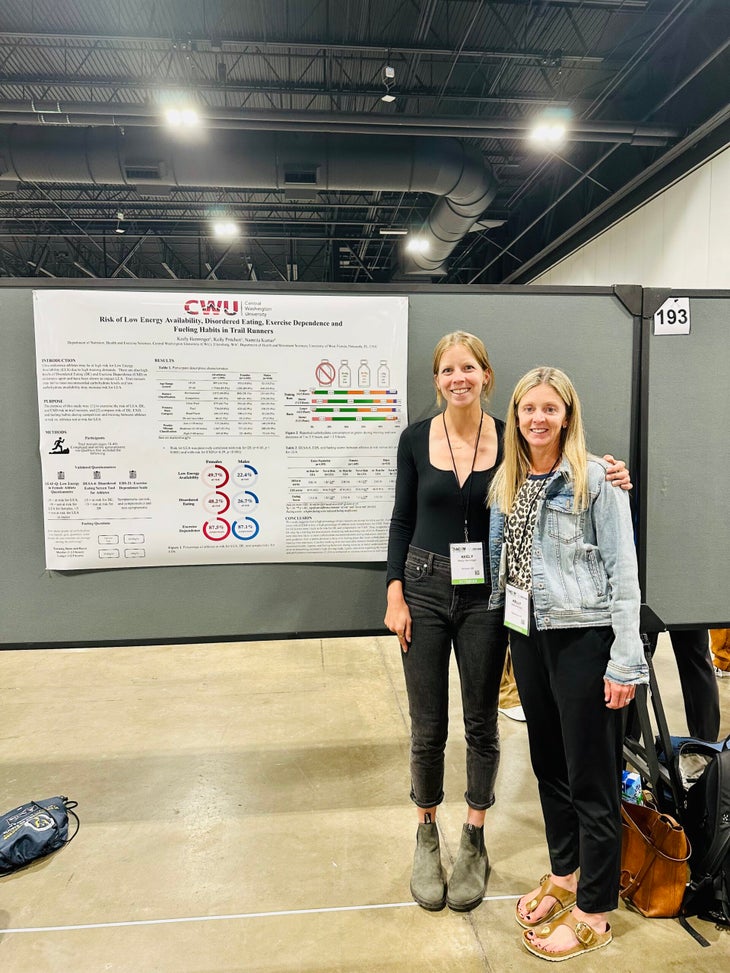A New Study Shows Connections Between Disordered Eating, Exercise Dependence, and Fueling in Trail Runners

“], “filter”: { “nextExceptions”: “img, blockquote, div”, “nextContainsExceptions”: “img, blockquote, a.btn, a.o-button”} }”>
New perk! Get after it with native options just for you. Uncover shut by events, routes out your door, and hidden gems whilst you
>”,”title”:”in-content-cta”,”sort”:”hyperlink”}}”>be part of the Native Working Drop.
This textual content discusses consuming issues and disordered consuming. For those who’re nervous about your particular person consuming, attain out to a trusted psychological properly being expert or Nationwide Consuming Dysfunction Affiliation.
Keely Henninger has prolonged been desirous about combining her love of research collectively together with her love of working, notably prolonged distances off-road. As an elite athlete for Altra and two-time Western States 100 Golden Ticket winner, she’s had her finger on the guts beat of narratives inside the endurance world that run counter to her scientific experience.
“As soon as I first started path working, fueling was not talked about,” says Henninger, 31, who lives and trains in Portland, Oregon. In chatting with her totally different athletes, she seen quite a lot of misconceptions—even on the excessive of the sport—about what it means to gasoline efficiently for the extreme diploma of vitality path and ultrarunning required. And, frankly, that was concerning for any person who studied biology and has beforehand labored in evaluation positions for Nike.
“If one thing, the dearth of fueling was praised,” she says.“Points like stress accidents or shedding your interval have been practically a badge of honor. My scientific thoughts took curiosity in fueling and started diving deep into the damaging properly being outcomes associated to not fueling appropriately and the benefits of fueling appropriately.”
Low vitality availability (LEA) occurs when athletes don’t eat enough vitality to help basic physique processes after practice. LEA can impression properly being, along with bone, endocrine, metabolic, and totally different physiological processes. In keeping with some estimates, between 22 to 58 p.c of endurance athletes have LEA, with a barely bigger prevalence in female athletes, notably those who participate in sports activities actions that emphasize specific physique varieties, like working. Whereas feminine and male athletes could also be at risk for LEA, it presents another way all through populations.
Closing yr, Henninger joined fellow researcher Kelly Pritchett, a professor of Vitamin and Prepare Science at Central Washington School, to develop a scientific survey that used beforehand developed devices to judge consuming dysfunction menace, LEA, and that may seize attitudes, data, and habits related to fueling, practice dependence, and disordered consuming in athletes, the first look at notably of path runners.
Whereas there could also be quite a lot of anecdotal proof that factors like Relative Energy Deficiency in Sport (REDS) are frequent, this look at represents the first quantitative analysis of its prevalence and connection to consuming issues and practice dependence. The look at might be printed in early 2024.
“The goal [of the study] was to basically take into account the hazard of all of these on this group of runners, Henninger says.“
“One factor novel in our look at was to tie all of this to their fueling strategies because of we now have quite a lot of data on athletes from all utterly totally different sports activities actions that current how prevalent low vitality availability is,” she says. “Nonetheless, none checked out all three of them combined after which how they correlated to fueling practices because of everyone knows that carbohydrate availability is important for sustaining vitality homeostasis. Attempting to see that relationship, notably in our sport, us.”
“Prior evaluation has examined the hazard of disordered consuming and low vitality availability inside the working inhabitants,” says Pritchett. “Nonetheless, evaluation has however to have a look at this in path runners, who arguably have bigger teaching volumes (interval teaching and mileage) thus rising the hazard of LEA.”
Henninger says that many path runners actually really feel like they’re coping with an uphill battle when figuring out their fueling.
“Path working by itself could also be fairly easy. It’s lovely to easily exit inside the mountains by your self two toes, nonetheless the game might be rising and getting further aggressive, and I really feel we now have the accountability to contemplate long-term properly being,” says Henninger.
“All through situations of elevated teaching, athletes should eat further to adapt to the teaching stimulus, help properly being, and to optimize effectivity,” says Pritchett. “This may require additional work to ingest ample vitality spherical and thru teaching, notably when urge for meals does not match the vitality wished (i.e., Devour a post-exercise snack that is extreme in carbs together with protein, enhance the amount of carbs in your pre-exercise snack (take into account points like a further scoop of oats, bananas, or sweet potatoes).”
RELATED: Are A couple of of Your Correctly-Supposed Consuming Habits a Disadvantage?

Extreme Hazard for Low Energy Availability
In keeping with the look at, which surveyed practically 2,000 path runners, 43 p.c have been at risk for LEA, which implies they displayed indicators of not consuming enough vitality to gasoline their train diploma.
“The fueling habits are probably basically probably the most fascinating discovering to me,” says Pritchett. “Us sports activities actions dietitians have our work cut back out for us.”
A key ingredient of fueling that the researchers examined was if athletes took in enough carbohydrates for teaching runs. The researchers found that, whereas athletes tended to absorb enough gasoline for runs beneath 2.5 hours, the majority (53 p.c) didn’t take in enough gasoline (60-90g of carbohydrate per hour) for runs longer than 2.5 hours.
Youthful and female athletes skewed further in path of underfueling. Whereas most athletes have been nearer to meeting ideas for fueling all through races, a stark 55 p.c of female athletes did not fulfill fueling recommendations on teaching runs over 2.5 hours. Henninger says that, whereas the knowledge didn’t shock her, it was validating to see it firsthand.
“I would like of us to know that whereas it might merely actually really feel like they’re skimping on one run, in any other case you actually really feel similar to you’re merely being strong and working via it, these practices are correlated with damaging properly being outcomes which can not manifest instantly,” says Henninger. “It’s detrimental to your future as an athlete.”
Henninger elements to an absence of coaching as a key take into consideration underfueling all through teaching and racing.
“There is a lack of understanding on this home and an absence of accountability by vitamin companies,” says Henninger. “So many vitamin merchandise say ‘take every 45 minutes’ and comprise 30g of carbs, which isn’t enough. So athletes ought to do their due diligence in coaching and by no means on a regular basis perception the wrapper.”
“For a lot of people, that’s more likely to be the one data and vitamin suggestion they see,” she gives. “And they also might assume the minimal will work for them. So all of us should do a larger job of highlighting the importance of appropriate fueling.”
RELATED: Males, Are You Consuming Enough to Fuel Your Prepare?
Correlation With Consuming Points, Disordered Consuming and Prepare Dependence
Disordered consuming has moreover been acknowledged as a take into consideration LEA. Examples of disordered consuming can embody skipping meals, proscribing vitality (like all through in-run fueling, as talked about above), and a dangerous preoccupation with meals. This look at, along with others assessing the endurance athlete inhabitants and folks participating in body-image-focused sports activities actions, implies that 43 p.c of the inhabitants, principally females (48 p.c of females are at risk for disordered consuming versus 27 p.c of males, with youthful females being on the best menace), are at risk for disordered consuming. Nonetheless, some athletes ought to nonetheless qualify as at-risk for LEA with out exhibiting disordered consuming or an consuming dysfunction.
The look at moreover acknowledged that the majority path runners studied have been “non-dependent symptomatic” for practice dependence, a dysfunction the place of us practice compulsively and obsessively to the aim of damaging outcomes like illness or harm. As soon as extra, female runners have been further at risk than their male counterparts for practice dependence, which could moreover end in additional vitality availability factors related to over-exercising and by no means consuming enough vitality.
In keeping with the look at, many path runners are at risk for LEA and disordered consuming. Whereas many may not meet a scientific diploma of practice dependence, a very good portion over half exhibit indicators of practice dependence that may extra exacerbate vitality availability. Whereas a lot of these conclusions might actually really feel intuitive to a runner who’s seen conversations spherical fueling evolve, they degree to the reality that additional coaching domestically is required.
“This look at will hopefully enhance consciousness regarding the specter of LEA on this inhabitants and what to do about it,” says Pritchett. She says assessing if an athlete’s vitality deficit is intentional or unintentional is important, and sync up with a care crew to help proper the course.
Henninger agrees that elevated consciousness and coaching are most important when paired with movement.
“An important takeaway from my evaluation is that there is plenty of significance in fueling all through prolonged endurance events that not solely will make it simpler to achieve your potential inside the temporary time interval, nonetheless it ought to make it simpler to mitigate future properly being outcomes that will very properly be damaging or detrimental to your properly being and as well as keep you inside the sport longer,” says Henninger. “I really feel all people can do their due diligence to observe fueling of their teaching and of their racing and work out a level that works for them. We’ll acknowledge that it’s not going to be a one-size-fits-all sort of fueling method. Nonetheless, we are going to all agree that correct now, we’re not pretty hitting the mark, notably with the extreme ranges of these, one factor like lower availability on this neighborhood that will very properly be damaging to their properly being.”
RELATED: The Significance Of Consuming Enough Meals
Additional Evaluation and Coaching is Wished
Ignorance is a key trigger that many runners underfuel, simply because they didn’t know that they wished to increase carbohydrate consumption as a result of the dimensions of runs will enhance (from 30-60g/carbohydrate per hour on runs beneath 2.5 hours to 60-90g of carbohydrate per hour on runs over 2.5 hours).
Athletes should be cautious of unchecked particulars about fueling and diets they encounter from unverified sources, notably on the internet. They should search skilled enter, ideally from a sports activities actions dietitian, to help dial of their specific desires. Coaches should actually really feel cosy asking questions on menstrual properly being, accidents, and fueling all through teaching and rivals and be succesful to degree athletes in the direction of additional sources when essential.
For her half, Henninger hopes the look at she co-authored might assist enhance consciousness, too.
“The model new narrative that I try and share with my athletes and to myself is that fueling typically is a superpower because of whilst you’re not fueling, you’re not working in your potential. It’s merely plain science,” says Henninger. “Fueling will not be going to solely assist you to attain new heights in your day-to-day effectivity however moreover let you’ve further longevity inside the sport and hold injury-free.”





